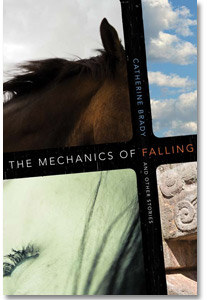
Reviews
Excerpts
Buy From:
IndieBound
Amazon
University of Nevada Press
|
The Mechanics of Falling
and Other Stories
Catherine Brady
University of Nevada Press
ISBN 978-0-87417-763-3 www.unpress.nevada.edu/books.asp?ID=2531
About the book:
These stories, set largely in San Francisco, are about what happens when the seemingly fixed coordinates of our lives abruptly give way—when mother love fractures, the faithful husband abandons his family, a conscientious middle-class life implodes, loyalty demands excruciating sacrifices. The characters in these stories—a college student waitressing in a remote resort in the Sierras, a devout Christian man who works in a shelter for the homeless, a faded Berkeley radical, a privileged young woman who can’t figure out whom to blame for her inexplicable discontent—share a fundamental predicament, the struggle to name and embrace some faith that can break their fall. In equal measure, they hunger for and resist this elusive possibility and what it demands of them.
What one is willing to risk for the sake of transformation—or for the right to refuse it—is a particularly thorny dilemma for the women in these stories. In “Looking for a Female Tenet,” college student Mary Lee, bent on freeing herself from her working-class upbringing, betrays her allegiance to an embittered reading of the world’s offerings. “Slender Little Thing” relates the story of Cerise, who has worked all her life in menial jobs, and the story’s structure deconstructs the ways in which that does and does not define her, unpacking what is subsumed in a few sentences in the opening paragraph. In “The Dazzling World,” Judith, stuck in a relationship that has arrived at a stalemate, travels to an archaeological site in Guatemala to find that while she can’t shed her sense of loss, she is somehow buoyed by the small tokens of hope she discovers, reading in them a message as lucid as the geometry of a crystal.
The collection opens with “Looking for a Female Tenet,” in which the image of a narrow box haunts the action and traps Mary Lee, and ends with “Wicked Stepmother,” in which Lexie’s hope for transformation is embodied in the image of the ark, which couldn’t possibly have contained its cargo. These stories trace the effort to traverse the boundaries between one state and another—between conviction and self-doubt, recklessness and despair, resignation and rebellion—and each of them ends at a moment meant to propel the reader to imagine what’s next, to register the unfinished quality of every life.
|
|
